| |
12/7/2019 |
A longtime coworker's son went to Pittsburgh to study
engineering. As part of a work study program, he went
to Belgium to study engineering at various enterprises. One of
his mementos was a beer bottle. My coworker,
knowing that I collected bottles, gave it to me one day. I was blown away because this bottle had a
unique band around the neck that I had not seen on a modern
bottle.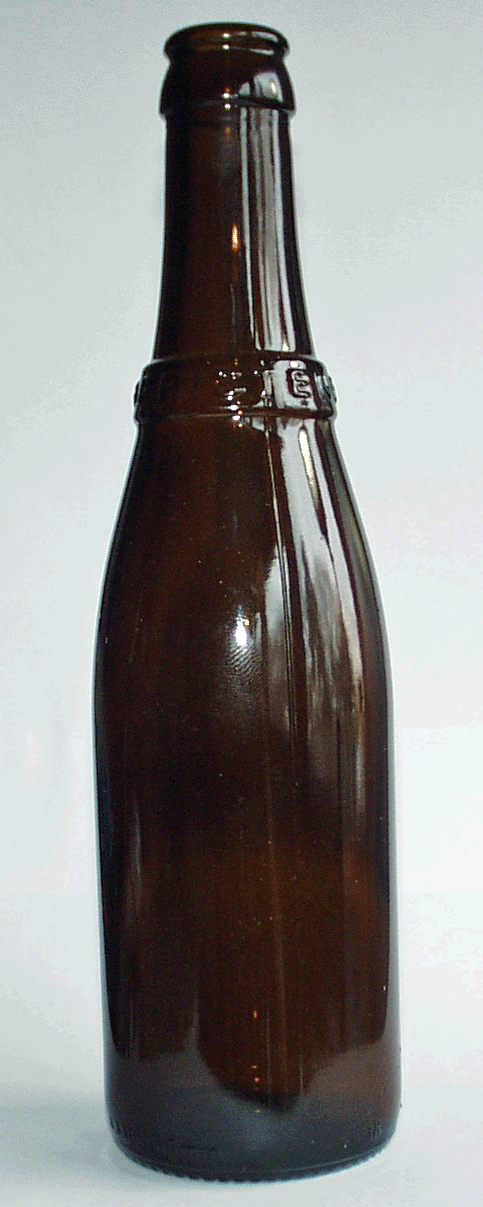
The bottle was from a Trappist Brewery located near
Vleteren, Belgium and is embossed on
the neck band "TRAPPISTENBIER." This brewery is run by
Trappist monks and actually there are about a dozen Trappist
monasteries across the globe that brew beer and sell it to
the public. On their their web site,
The Brewery Of The Saint-Sistus Abbey, the following history is
provided:
In 1814 Jan-Baptist Victoor settled as a hermit
in the woods of Westvleteren, where monastic communities had
already living long before. The history of the Saint-Sixtus
Abbey started when some monks of the French abbey
Mont-des-Cats joined the hermit in 1831.
Aside their
monastic activities the monks also cultivated the fields
around the abbey, produced cheese… in order to be
self-supportive. Already in the early days beer was brewed
in small quantities, not for sale but just for their own
consumption. The Saint-Sixtus Abbey’s archive reveals that
the first expenses for a brewery were made in June 1838.
In May 1839, the Abbey received a brewer’s license
signed by king Leopold I on April 19, 1839. Most likely
a first test brew was produced the same month. In June
1839 the first official brew was produced. The 25,45
Belgian francs paid for the rights of the two brews bear
witness to this.
This bottle likely held Trappist Westvleteren,
which was touted as the best beer in the world.
Getting the beer is no easy task. It is sold in wooden
crates of 24 bottles. The beer is only sold to
registered individuals and is only for personal use.
As production is limited and you may have to wait a month or
more after registering to be able to pick up your order.
Yes it can only be picked up at the abbey and a deposit is
required on the bottles and case.
Why was I blown away? Well this is not the first time a have seen an embossed band
on the neck of a beer bottle. If we go back about 160
years, there is a similar bottle marked Espy. This is
the bottle of Philadelphian Mills B. Espy, who
is generally
known for his food bottles.
Espy  is first listed in the Philadelphia Directories as a
broker on South Third Street in 1841. This was an
occupation that he continued until he partnered with Jacob
L. Wendell as Wendell & Espy, who purchased the pickle and
preserve works of Thomas B. Smith & Company in July of 1851.
Wendell was Smith's partner in T. B. Smith & Company and
Espy likely provided needed capital to purchase Smith's
share. is first listed in the Philadelphia Directories as a
broker on South Third Street in 1841. This was an
occupation that he continued until he partnered with Jacob
L. Wendell as Wendell & Espy, who purchased the pickle and
preserve works of Thomas B. Smith & Company in July of 1851.
Wendell was Smith's partner in T. B. Smith & Company and
Espy likely provided needed capital to purchase Smith's
share.
The Pickle factory was located at 152 South Front
Street (post-1857, 312 South Front). In 1854, a new
location was opened at 109 South Third Street (post-1857,
255 South Third). The Wendell & Espy partnership
lasted thru May of 1855, when it was dissolved. With
the split, each partner continuing their pickling and preserve
business at separate locations. Wendell retained the
old factory on South Front and Espy moved to new factory on
South Third. Espy called his factory the Philadelphia
Pickling Depot and Wendell called his the American Pickling
& Preserving Establishment.
In May of 1858, if not earlier, Espy appears to have
entered the business of bottling beer. Initially he
advertised bottled porter, but later added ales and lager beer. It
is during this time that Espy had his marked porter bottles
manufactured. By 1859, he moved the business to 712 Market
Street and appears to have continued bottling beer. He
also added
chocolate to the list of his manufactured products. It
appears that the changes in location and extended product
line proved too much for Espy and he offered his business
for sale in May of 1860. Not getting any offers, the
business was sold at auction in September of the same year.
But what about the band? Thinking about it, I
recall some bottles pictured in Willy Van den Bossche's epic
book Antique Glass Bottles Their History and Evolution
(1500-1850).  These bottles had applied metal bands
around the neck and were measuring bottles. The liquid
would be poured into the bottle up to the band and that
would represent a full measure. The bottles were
certified by local officials so that the public would know
that they were getting the correct measure of the product
that they were purchasing. They were used to dispense
wine, oil, or other valued products. Van den Bossche
states that there bottles were used in South-western France
during the first half of the Eighteenth Century. Did
that tradition continue and is the band on the Espy and
modern beer bottles an outgrowth of this desire to show full
measure? These bottles had applied metal bands
around the neck and were measuring bottles. The liquid
would be poured into the bottle up to the band and that
would represent a full measure. The bottles were
certified by local officials so that the public would know
that they were getting the correct measure of the product
that they were purchasing. They were used to dispense
wine, oil, or other valued products. Van den Bossche
states that there bottles were used in South-western France
during the first half of the Eighteenth Century. Did
that tradition continue and is the band on the Espy and
modern beer bottles an outgrowth of this desire to show full
measure?
The band does appear to be in the proper location on
both the old and modern bottles to indicate the proper
liquid height for a proper measure. At the very least,
it could have been a guide to the bottler as to how much
liquid should be added to the bottle. A check of the
modern bottle shows that the actual filling of the bottles
is to about an inch above the band. So a measuring guide
seems unlikely, at least for today.
Perhaps the band is just an advertising replacement for the
paper bands that are a traditional identification of the
product in the bottle, but being so small, that seems
unlikely.
It also seems
unlikely that it was used as a grip to ensure a firm grasp,
like the hobble nails on the neck of some 1920-1930 milk
bottles, as it is not in the exact place where you
would hold the bottle.
None of these three ideas seems plausible and am out of
ideas and looking for suggestions. Email me with your
thoughts. There must be
some tradition somewhere that explains this. In any
case, there we have it. One bottle from the Nineteenth
Century and another from the Twenty-First and both using the same
distinctive decoration on their necks.
Image of band on measuring bottle courtesy of Willy Van
den Bossche's from Antique Glass Bottles Their History and Evolution
(1500-1850). Others collection of the author.
|
|
|
1/19/2019 |
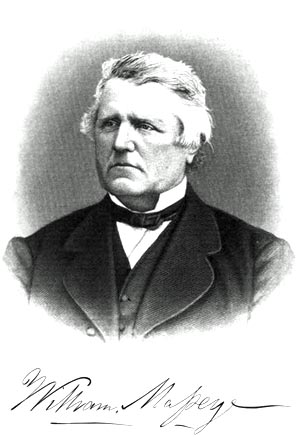 William Massey
was started his brewing career in England, picked it up in Philadelphia
on his arrival in the United States, operated as
a bottler in New Orleans, and ended his career as a major
force in Philadelphia's brewing industry. William Massey
was started his brewing career in England, picked it up in Philadelphia
on his arrival in the United States, operated as
a bottler in New Orleans, and ended his career as a major
force in Philadelphia's brewing industry.
From the Biographical
Encyclopedia of Pennsylvania of The Nineteenth Century
published by the Galaxy Publishing Company in 1874, we get some background on Massey:
MASSEY, WILLIAM, brewer was born in
Liverpool, England, England, November 16th, 1808.
When he was a year old, his father removed to Hawley
Potteries, in Staffordshire, where he received his
education. After leaving school, he entered his
father's establishment, where he learned the business of
Brewing. In 1828, he emigrated to the United
Sates, the voyage occupying five months, as the
vessel--through stress of weather—was obliged to put
into Fayal to repair and refit. On his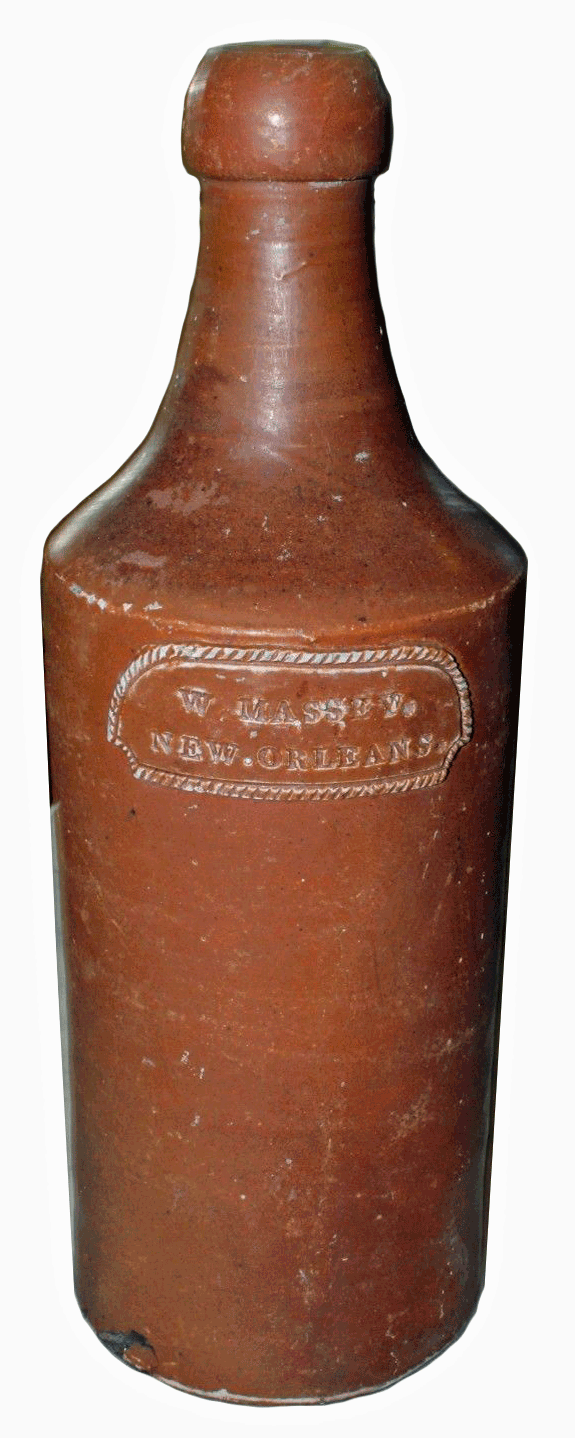 arrival in
Philadelphia, he found employment in Gray's Brewery, on
Sixth street, where he remained two years, and then
proceeded to New Orleans, becoming engaged in that city
in the bottling business. He dwelt there for twenty-four
years, and during the entire period, enjoyed the best of
health, never experiencing any of the miasmatic diseases
so common to that locality. Always actively engaged in
attending to the manifold details of his business, he
prospered greatly from year to year. In 1849, and five
years prior to leaving New Orleans, he became a member
of the firm of Poultney, Collins & Massey, who had
purchased the interests of M. L. Dawson, in the
extensive brewery located at the northwest corner of
Tenth and Filbert streets, Philadelphia. In 1854, he
returned to the North, where he has ever since resided,
giving his whole attention to the business, as head of
the firm of William Massey & Co., his associates in that
house consisting of John Gardiner, James M. Hall, and
William Massey Robinson. The brewery and malt house is
the largest in the State, and perhaps the most extensive
in the Union, there having been brewed during the season
of 1872-3, the enormous quantity of 113,000 barrels of
ale and porter, each vessel having a capacity of 30
gallons. To produce this; result, 250,000 bushels of
barley, and 125 tons of hops were used. Personally, he
is a genial, modest, unassuming man of kindly
disposition and winning manners. He is one of the most
generous and charitable of citizens, and his bounties
are large and well bestowed. He is a member of the
Albion and Hibernian Societies, and has been for a long
while Vice-President of the Society of the Sons of St.
George. In political faith, he is a Democrat, and since
the establishment of the Reform Club, has been elected
one of its Governors. He is prominent in every
enterprise intended for the development and improvement
of the city, and increase of its commerce. He was
married, in 1830, to Fanny, daughter of Samuel Miller,
of Bridgeton, New Jersey. arrival in
Philadelphia, he found employment in Gray's Brewery, on
Sixth street, where he remained two years, and then
proceeded to New Orleans, becoming engaged in that city
in the bottling business. He dwelt there for twenty-four
years, and during the entire period, enjoyed the best of
health, never experiencing any of the miasmatic diseases
so common to that locality. Always actively engaged in
attending to the manifold details of his business, he
prospered greatly from year to year. In 1849, and five
years prior to leaving New Orleans, he became a member
of the firm of Poultney, Collins & Massey, who had
purchased the interests of M. L. Dawson, in the
extensive brewery located at the northwest corner of
Tenth and Filbert streets, Philadelphia. In 1854, he
returned to the North, where he has ever since resided,
giving his whole attention to the business, as head of
the firm of William Massey & Co., his associates in that
house consisting of John Gardiner, James M. Hall, and
William Massey Robinson. The brewery and malt house is
the largest in the State, and perhaps the most extensive
in the Union, there having been brewed during the season
of 1872-3, the enormous quantity of 113,000 barrels of
ale and porter, each vessel having a capacity of 30
gallons. To produce this; result, 250,000 bushels of
barley, and 125 tons of hops were used. Personally, he
is a genial, modest, unassuming man of kindly
disposition and winning manners. He is one of the most
generous and charitable of citizens, and his bounties
are large and well bestowed. He is a member of the
Albion and Hibernian Societies, and has been for a long
while Vice-President of the Society of the Sons of St.
George. In political faith, he is a Democrat, and since
the establishment of the Reform Club, has been elected
one of its Governors. He is prominent in every
enterprise intended for the development and improvement
of the city, and increase of its commerce. He was
married, in 1830, to Fanny, daughter of Samuel Miller,
of Bridgeton, New Jersey.
Massey was advertising the sale of Albany Ale in 1835 and
Philadelphia Brown Stout in 1836 from 155 Old Levy.
Ten years later, he was selling beer from 20 Beinville
Street. An advertisement in the Times-Picayune
newspaper on February 11, 1846 indicates Massey used ceramic bottles:
Notice.
THE undersigned has just imported from England at
considerable expense a quantity of Stone Bottles for his
Porter, Ale and Cider business. He hereby warns
all dealers not to purchase any of them, as they are
stamped with the name of the undersigned, and are
intended for his private use only.
WM. MASSEY, 20 Beinville st
Several of Massey's bottles, like the slab seal
illustrated above, are clearly of English manufacture.
It is likely Massey used his connections back in
Staffordshire, England to have the bottles made and imported
to New Orleans.

Massey appears to have been an agent for the M. L. Dawson
& Company porter and ale brewery on the Northwest corner of
North Tenth & Filbert Streets in Philadelphia. This
brewery was founded, about 1823, by farmers who were not
satisfied with the prices Philadelphia brewers were paying
for their grains and was called the Farmer's Brewery. They went out of business during
1827 and the contents of the brewery were sold in the Fall
of that year. The brewery was purchased by Mordecai L.
Dawson as noted in Poulson's American Daily Advertiser
Friday, Jun 19, 1829:
The Farmer's Brewery, at the corner of Tenth
and Filbert-streets, was purchased on Tuesday last by
Mr. Mordecai L. Dawson, for the sum of twenty-five
thousand dollars. There is a ground rent of 700
dollars per annum on the premises. The original
cost of the property was 70,000 dollars.
1849 was a pivotal year for Massey as documented in the
New Orleans Crescent on November 14, 1849:
DISSOLUTION-The co-partnership heretofore
existing under the firm of M. L. DAWSON & CO., is this
day dissolved by mutual consent. The business of
the plate firm will be settled by their successors,
POULTNEY, COLLINS & MASSEY.
M. L. DAWSON,
CHAS. W. POULTNEY
WM. WAYNE WISTER.
Philadelphia, 10th Month 4th, 1849.
___________________
CO-PARTNERSHIP--The subscribers having purchased the entire
interest of M. L. DAWSON & CO., will continue the
BREWING BUSINESS under the firm of POULTNEY, COLLINS &
MASSEY, Philadelphia, and MASSEY, POULTNEY & COLLINS,
New Orleans.
CHAS. W. POULTNEY,
F. COLLINS,
WILLAIM MASSEY.
Philadelphia, 10th Month, 4th, 1849.
____________________
THE subscriber having connected himself in business as per
the above advertisement is prepared to supply his
friends and the public with PORTER, ALE, and EXTRA ALE
FOR BOTTLING, and PALE AND AMBER ALE FOR DRAFT, by the
cask or barrel, at the premises formerly occupied by
him, Nos. 19 and 21 Beinville street, under the name and
style of MASSEY, POULTNEY & COLLINS. He would also
inform them that he has sold out his "Bottling Business"
to his brother-in-law, N. MARACHE, and would recommend
him to their patronage.
New Orleans, Nov. 1, 1840.
WILLIAM MASSEY
____________________
THE undersigned having purchased the BOTTLING ESTABLISHMENT
of Wm. MASSEY, 23 Bienville st., will continue the
business at the "old stand," where he will keep on hand
a supply of PORTER, ALE AND CIDER of the best quality,
and solicits a continuance of their patronage hitherto
bestowed on their predecessors.
New Orleans, Nov. 1, 1849
N. MARACHE.
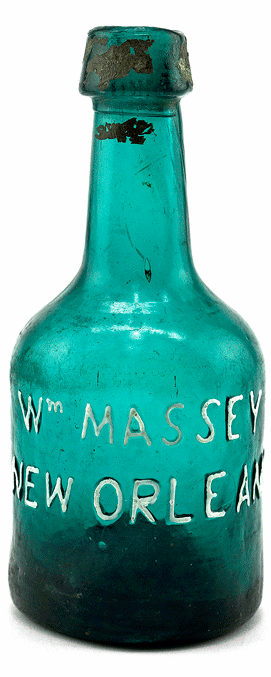
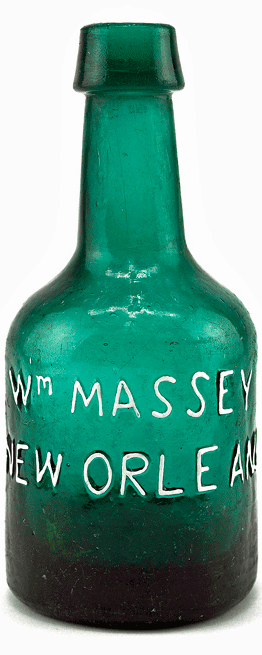
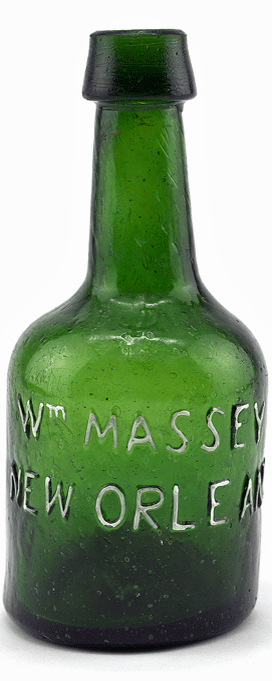
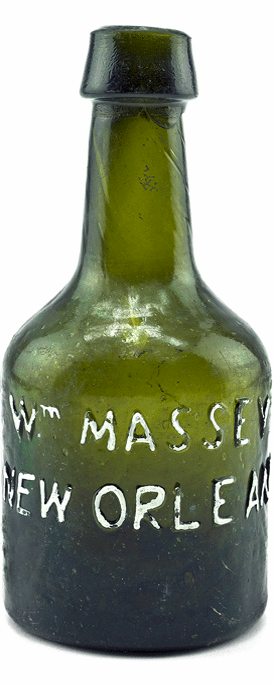
The above porter bottles date about 1847 to 1849, when Massey sold
his bottling establishment to his brother-in-law Edward
Nicholson Marache and focused
on the wholesale distribution of Poultney, Collins & Massey
beers. These bottles have the appearance of Pittsburgh
or Midwestern manufacture.
Massey moved back to Philadelphia in 1854 to more closely
manage the brewing business. The firm became Poultney
& Massey during 1854, Massey, Collins & Company during 1858.
Marache continued the bottling of porter, ale and cider,
in casks, barrels and bottle both wholesale and retail at 19
and 21 Bienville thru at least 1855 as advertised in the
1855 New Orleans Directory. Marache's wife Hanna died
in 1856 and in the July 26, 1856
edition of the Times-Picayune, T. F. Murray advertised that
he was the "Successor to N. Marache" and was a dealer in
"Ale, Porter and Cider wholesale and retail" at 19 and 21
Bienville street. Murray continued the business thru
1858. In February Also in 1856, Marache and a H. Bidwell
formed a partnership to conduct a Western Produce and
Commission business, but Marache resumed the bottling business as advertised in
the June 20, 1858 Times-Picayune:
NOTICE.
The advertiser begs leave to inform his friends and the public that has
resumed the Bottling business at his old stand, Nos. 19
and 21 Bienville street, where he will keep a full
assortment of PORTER, ALE AND CIDER of the very vest
quality.
Also a superior article of DRAUGHT ALE AND CIDER, LAGER BEER, CORKS,
BOTTLES, &c.
Families supplied with an extra article.
N. MARACHE
19 and 21 Bienville street
Macache continued to advertise thru 1859 and was listed
in the July 1860 tax roles, but appears to have vanished
from the record. There are no known Marache or Murray
bottles. With the exit of Marache, Massey no longer had an agent in New
Orleans and urged Louis C. Arny to go there and represent
the brewery: apparently at 52 New Levee. Soon after the Civil War
started and Arny, loyal to the south, joined the Southern
Army. More on Arny later. The war would paralyze trade in
the South and the shipping of beers from the North was
halted until the battle for New Orleans was over. The
City was taken by Union forces in May of 1862. The
city of New Orleans slowly reopened for business as it did
not face the utter destruction that befell many of the other
Southern Cities. On June of 1863, William Massey was
back in New Orleans as advertised in the Times-Picayune on
June 19, 1863, when he was located at 26 & 28 Bienville and
wished "to buy bottles and jugs." On November
10, 1863, Massey advertised that he was selling out his
bottling works to John A. Blaffer. The ads
appeared in the Times-Picayune:
Notice.
HAVING sold out my entire interest in the Ale and Porter
Bottling Establishment, Nos. 26 and 28 Bienville street
to Mr. J. A. BLAFFER, I would return my most sincere
thanks to the public for the patronage bestowed on me
for many years past, and now take pleasure in
recommending my successor, who will continue the
business at the same old stand.
William Massey
This ad was followed by one for John A. Blaffer
announcing he was the "SUCCESSOR TO WILLIAM MASSEY." J. A. Blaffer
continued to advertise for bottles and selling ales and
porters at 26 & 28 Bienville thru 1864. With the
War, bottles must have been a scare commodity.
Massey returned to Philadelphia a second time. The
Philadelphia brewery became
Massey, Huston & Company during 1867, William
Massey & Company during 1869 and finally The William
Massey Brewing Company during 1882. During these years the
brewery when thru a large number of improvements and was at
one point the eleventh largest brewery in the United States.
The picture below from 1872 shows how the brewery expanded as compared
to its appearance in 1831 as illustrated above
when under the direction of Dawson.

Massey died a millionaire on February 16, 1891 and
although contemporary authors state that the brewery went
downhill without his leadership and closed
in 1894, this is just not true. The facts
are laid out in The Times on April, 26, 1891, just a few
months after Massey's death:
Betz Absorbs Massey.
Arrangements for the purchase of the entire stock and goodwill of the
William Massey Company by John F. Betz & Son, Limited,
have been consummated, and on the first of the next
month the Massey Company will go out of the brewing
business. The causes that led to this were
several, among them being the death of Mr. Massey, the
necessity for settling his estate, and the great decline
of late years in the consumption of ale, owing to the
great increase in demand by Americans for lager beer.
In 1893, the brewery property and buildings was sold for
$325,000 and included ground rents of $325.25 a year.
It was demolished later that year to make way for a large
commercial building that cost over $600,000 to build.
As part of the demolition, 2 million bricks were offered for
sale. The story now returns to New Orleans and Baffler
& Company.
In January 1865, J. A. Blaffer & Company
advertised for the first time, extensively advertised that
they were agents for
 Massey, Collins & Company's celebrated
Philadelphia XX ale and porter and opened a new location at
52 New Levee Street. The 26 & 28 Bienville address was
reserved as the bottling house and the 52 New Levee address
was the wholesale location. In October of 1865, the
firm received seven casks of bottles from Pittsburgh on the
steamer Dictator. In 1866 the bottling house extended
to include 30 Bienville Street. 1867 brought a move of
the wholesale location to 53 Gravier Street and the addition
of Gustavus Bergner's Philadelphia Lager Beer to the product
line and a steam malt mill at the bottling works. The
Fall of 1873 started to mark changes for the company that
would continue into the next year. First, as
advertised in the Times-Democrat on October 5, 1873, N. R.
Pepin retired from the firm on September 30 of that year and
"J. A. BLAFFER, will continue the business under the same
name and style as heretofore" and that the firm expired "by
limitation." we also learn that George Schaffer, a
long term employee of the bottling establishment, was taking
"charge of our store, No. 53 Gravier street. Massey, Collins & Company's celebrated
Philadelphia XX ale and porter and opened a new location at
52 New Levee Street. The 26 & 28 Bienville address was
reserved as the bottling house and the 52 New Levee address
was the wholesale location. In October of 1865, the
firm received seven casks of bottles from Pittsburgh on the
steamer Dictator. In 1866 the bottling house extended
to include 30 Bienville Street. 1867 brought a move of
the wholesale location to 53 Gravier Street and the addition
of Gustavus Bergner's Philadelphia Lager Beer to the product
line and a steam malt mill at the bottling works. The
Fall of 1873 started to mark changes for the company that
would continue into the next year. First, as
advertised in the Times-Democrat on October 5, 1873, N. R.
Pepin retired from the firm on September 30 of that year and
"J. A. BLAFFER, will continue the business under the same
name and style as heretofore" and that the firm expired "by
limitation." we also learn that George Schaffer, a
long term employee of the bottling establishment, was taking
"charge of our store, No. 53 Gravier street.
Almost exactly a year later, Blaffer & Company sold off
their bottling business as advertised in the October 2, 1874
edition of the New Orleans Bulletin:
NOTICE-HAVING SOLD OUT OUR ALE and Bottling
establishment, conducted for the past ten years at Nos.
26, 28 and 30 Bienville street, to Mr. LOUIS C. ARNY, we
beg leave to return our sincere thanks for the patronage
so liberally extended to us during that period.
And now we take pleasure in recommending our successor, Mr. L. C. ARNY,
to our friends and customers.
We shall continue the sale of HOPS, MALT, CORKS and BREWERS' and
DISTILLERS' SUPPLIES, at No. 53 (late 53) Gravier
street, where we shall be pleased to meet our old
friends.
J. A. BLAFFER & CO.
52 Gravier Street.
________________________
REFERRING TO THE ABOVE, THE UNdersigned notifies the
public that he will continue the BOTTLING BUSINESS at
Nos. 26, 28 and 30 Bienville street as heretofore
conducted by Messrs. J. A. Blaffer & Co., and
respectfully asks a continuance of public patronage so
long extended the old firm.
LOUIS C. ARNY,
26, 28 and Bienville Street.
New Orleans, Oct. 1, 1874

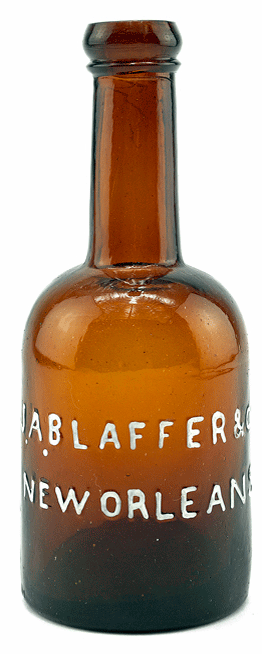
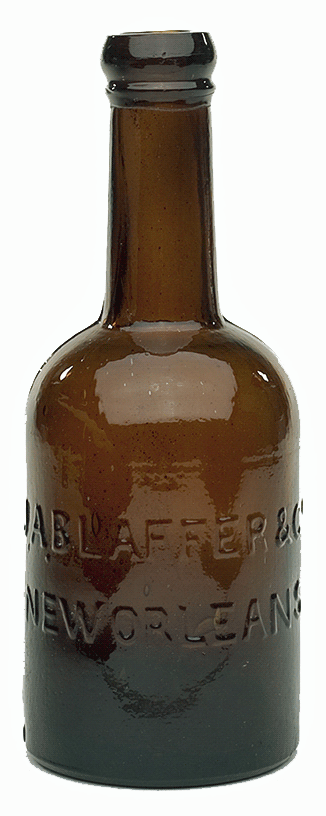
The above Blaffer & Company bottles have the appearance of Pittsburgh area
manufacture and are similar to bottles used in Louisville,
Ky. Some of them may well be from the above notation
of the receipt of bottles from Pittsburgh in 1865.
Louis Christian Arny was born about 1823 and was a clerk
for T. S. Waterman prior to purchasing the bottling business
of Blaffer & Company in 1874. In the 1875 New Orleans
Directory, Arny advertised: "Foreign and Domestic Ale, Porter,
Cider, Lager Beer and Ginger Ale in casks, barrels and
bottles." Soft drinks were a new product
line for the bottling works and were likely added based on Arny's experience working for Waterman, a longtime New
Orleans soda water bottler. By 1880, he had added
Lemonade and Sarsaparilla and was selling bottlers'
supplies. His son, William T., had also entered the
business as a clerk. During 1888, Arny moved his business to 19 Canal Street and the business
appears to have been more focused on soft drinks than that of
malt liquors. During 1894, Arny moved his business to 213 Carrol. The following year, the business
was relocated again. This time to 513 South Peters. Due to failing
health and advanced age, the elder Arny withdrew from active
management and William T. took over its management.
On July 27, 1902,
the elder Arny died and the business fell into the hands of
his widow Sarah. His son, William T. continued to
manage the business. The obituary of the elder Arny in
the New Orleans Item on July 28, 1902, recounts his life and
provides insight to his early life, but that is another
story. The business continued to be called L. C. Arny.
The company exhibited at the 1904 Columbus Exhibition in
Saint Louis and showed the following products: lemon soda, champagne cider, birch beer, raspberry soda, orange wine,
cream foam, New Orleans mead, ginger ale, celery and iron, lemon sour, Saratoga cream, cherry and pepsin orangeade.
In 1908, the business moved to 1101 Annunciation and in
advertisements in 1909 claimed to have been established in
1860, the year Arny came to New Orleans at the urging of
Massey. This same year they advertised "Happy Jack," a
non-alcoholic beverage that appears to have been a near-beer.
In 1912, if not earlier, the company began to advertise the
sale of "Dicky Bird" or Dicky Bird Celery. It
is described as follows in this Times-Picayune advertisement
on June 5, 1912: Bird Celery. It
is described as follows in this Times-Picayune advertisement
on June 5, 1912:
Thousands are fond of Celery---As a refreshment
nothing quite takes its place. As a tonic it has
no equal. Real, pure, unadulterated celery juice,
blended with pure granulated sugar and carbonated
distilled water in the proper proportion, looks like
fine champagne and is far more delicious as a table or
fountain beverage.
Such is ARNY'S DICKY BIRD CELERY. Used as mixing
agent for "hiballs" it greatly enhances the drink.
The best Fountains, Cafes and Restaurants have "Dicky
Bird" on the menu. This "Dicky Bird" Celery is
different from the hundreds of cheap concoctions known
under the name of CELERY TONIC.
In October 1913, The Dicky Bird Company was organized to
manufacture and market this new drink. Soon after
William T. Arny transferred the physical land and buildings and all movable
property to Henry V. Arny for $8,000 and on the same day
Henry V. Arny transferred the same land and movable property
valued at $20,600 to the Dicky Bird Company. Edwin W.
Arny, operated this company out of the old bottling establishment at 1101
Annunciation.
In the 1914 New Orleans Directory, the Dicky Bird Company
was listed as "Successors to L. C. Arny" with E. W. Arny
president and Wallace A. Hatkinson as secretary and
treasurer and sold "Carbonated Drinks, Syrups, and Dicky
Bird Celery". In May of 1915, the company was forced
into bankruptcy, apparently for nonpayment of notes due to
Miss L. C. Arny. Attempts to sell the company failed
and the business, property and movable assets were sold at
auction in September of that year. Included in the
sale were siphon bottles, bottlers supplies, open accounts
and trade mark 91,634 for the Dicky Bird Celery.
This brought to a close this long established New Orleans
business of 85 years. Interestingly, Dick Bird Syrup was still listed
for sale in a 1922
Druggist circular.

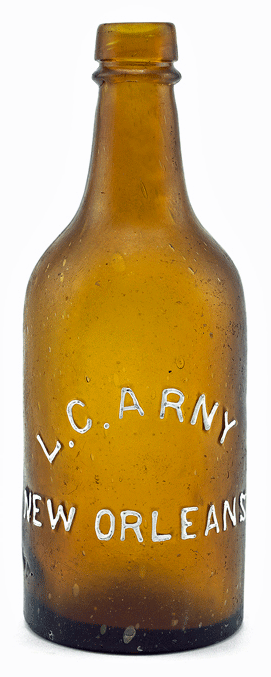

The early Arny bottles are clearly of Pittsburgh
manufacture and some are marked accordingly. These
include ale bottles, a semi-round bottomed bottle marked
ginger ale, and two different pony style bottles.
Later bottles include Hutchinson bottles and a crown top
bottle. One pony, one Hutchinson and the crown have
the mark of D. O. Cunningham, Pittsburgh.
There are no known Dicky Bird Company bottles.
Bottle images courtesy of Glass Works
Auctions and Ntqlvr. Dawson Brewery image courtesy of
the Library Company of Philadelphia.
|
|

